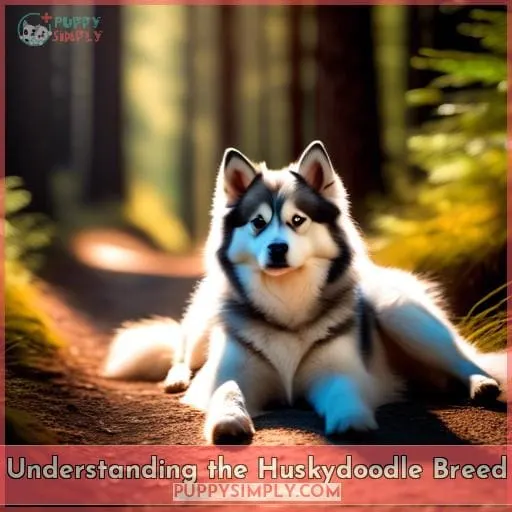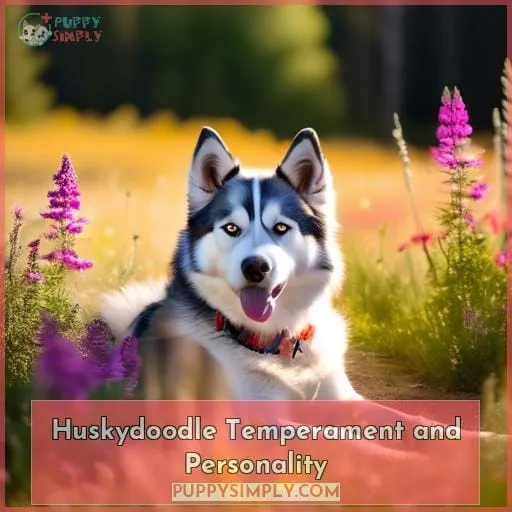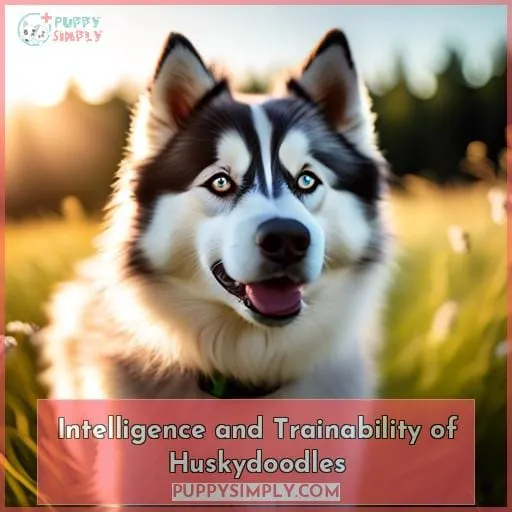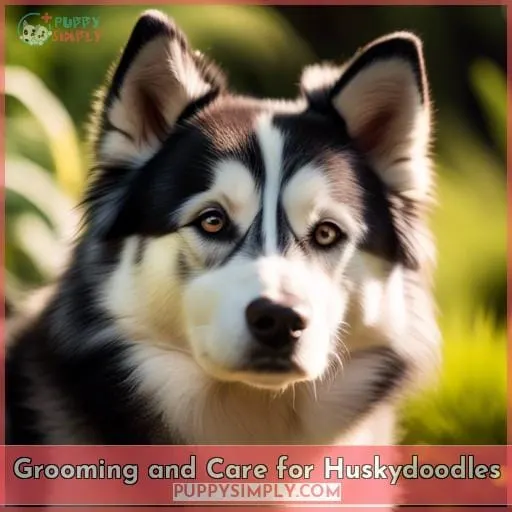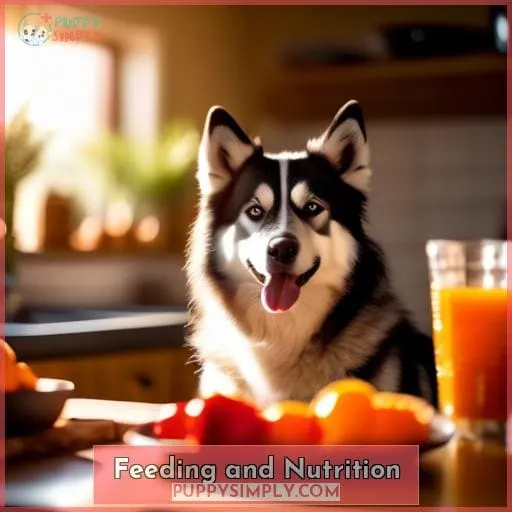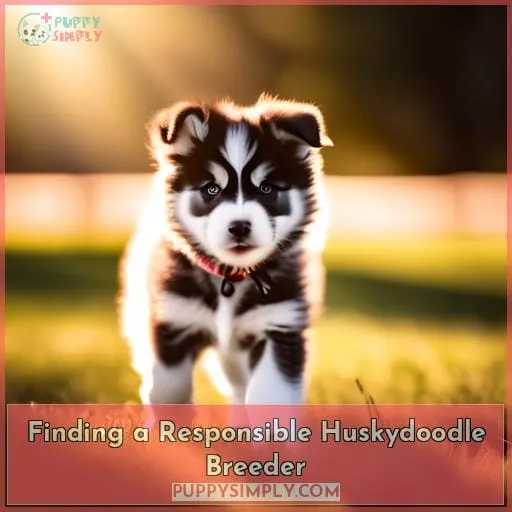This site is supported by our readers. We may earn a commission, at no cost to you, if you purchase through links.
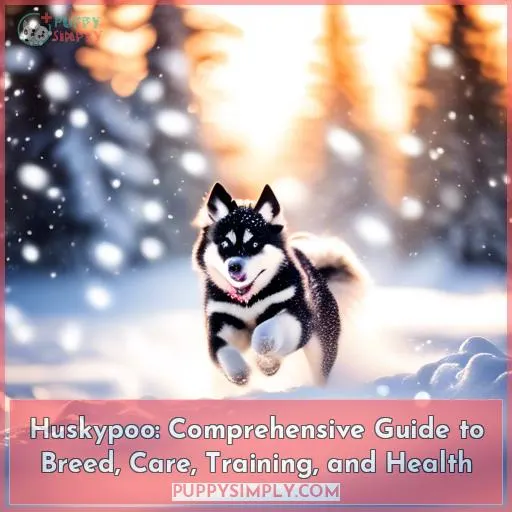 You think a Huskipoo might be too much dog? Think again.
You think a Huskipoo might be too much dog? Think again.
This friendly, intelligent companion’s poodle influence means less shedding and allergies.
Reward her cleverness with training and play, meet her high energy with good exercise, and she’ll cuddle right up on the couch at day’s end.
With moderate grooming needs and few health issues, Huskypoos make devoted family pets.
Just be sure you can match her zest for life, and this medium-sized crossbreed will overcome any doubt about her perfect fit.
Table Of Contents
- Key Takeaways
- Understanding the Huskydoodle Breed
- Physical Characteristics of Huskydoodles
- Huskydoodle Temperament and Personality
- Intelligence and Trainability of Huskydoodles
- Energy Levels and Exercise Needs
- Grooming and Care for Huskydoodles
- Health Concerns and Lifespan
- Feeding and Nutrition
- Finding a Responsible Huskydoodle Breeder
- Is a Huskydoodle Right for You?
- Frequently Asked Questions (FAQs)
- What is the best way to socialize a Huskydoodle puppy?
- How does the Huskydoodle interact with other pets, especially smaller animals?
- What specific activities or games do Huskydoodles particularly enjoy?
- Are there any specific dietary needs or restrictions for Huskydoodles?
- How does the Huskydoodle’s behavior and needs change as it ages?
- Conclusion
Key Takeaways
Here is the text with corrections:
- Huskypoos are high-energy dogs that require at least 60-90 minutes of vigorous exercise daily. They thrive in active households and are not suitable for apartment living due to their need for space and physical activity.
- This breed is known for its intelligence and trainability, but can also be stubborn at times. They form strong bonds with their families and are generally good with children and other animals, although supervision is recommended.
- Huskypoos have a lifespan of 10 to 15 years and can be prone to certain health issues such as hip dysplasia, allergies, and patellar luxation. Regular veterinary checkups, a balanced diet, and preventive care are essential for their health and longevity.
- The Huskypoo’s coat can be curly, straight, or wavy, and comes in a variety of colors including gray, black, white, red, apricot, cream, and brown. The level of shedding varies by coat type, and they have moderate grooming needs.
Understanding the Huskydoodle Breed
Here, we’ll take a closer look at the origin and history of the Huskypoo breed, as well as the variations and generations that have emerged over time.
Understanding where the Huskydoodle comes from provides insight into the unique combination of traits these dogs possess.
We’ll explore how crossing Siberian Huskies with Poodles first began and the different generations that have been bred.
Origin and History
The Huskydoodle originated in the late 20th century.
Breeders first crossed Siberian Huskies and Poodles to create a companion dog with the best traits of both parent breeds.
Crossbreeding gained popularity as people sought dogs with specific desirable qualities like low-shedding coats and high intelligence.
Breeders aimed to develop the friendly, energetic Huskydoodle by combining the Siberian Husky’s athleticism and work ethic with the Poodle’s trainability and minimal shedding.
This strategic crossbreeding exemplified broader trends in designer dog development.
Variations and Generations
There are several variations and generations of Huskydoodles that you’ll come across when looking for this mixed breed dog.
Genetic inheritance from parent breeds leads to size variations like miniature and standard Huskypoos.
Younger generations exhibit stronger hybrid vigor while health and traits stabilize through later generations.
Always consider genetic factors like size and coat when selecting your ideal Huskypoo variation.
Physical Characteristics of Huskydoodles
When it comes to the physical attributes of Huskydoodles, you’ll find they come in a range of sizes and coat colors.
Their size is dependent on whether the poodle parent was miniature or standard, while their coat can exhibit husky or poodle traits.
Key points of focus include typical Huskypoo size and weight, as well as common coat types and color variations found in the breed.
Size and Weight
Huskydoodles come in a range of sizes.
Males typically stand around 20 inches tall and weigh between 45-60 pounds.
Meanwhile, females are slightly smaller.
Weight management and an appropriate exercise regimen are important.
Their nutritional needs change during different growth phases.
The mini and standard huskydoodle variations differ in shedding.
However, all require monitoring their size and weight for health.
Coat Type and Colors
With regard to coat types and colors, Huskydoodles’ coats come in a variety of textures and Siberian Husky-inspired colorations.
Coat types:
- Curly coats
- Straight coats
- Wavy coats
Common coat colors:
- Gray
- Black
- White
- Red
- Apricot
- Cream
- Brown
Shedding levels vary depending on the coat type.
Huskydoodle Temperament and Personality
You’ll want to understand the affectionate yet loyal nature of the Huskypoo.
This breed forms strong bonds with their family and thrives when there’s plenty of interaction.
We’ll explore how the Huskydoodle gets along with children and other animals.
Affection and Loyalty
In terms of affection and loyalty, Huskydoodles are known for their deep bonds with family members.
They showcase their love through playful and affectionate behavior.
These devoted relationships are marked by loyalty cues, such as following you around or resting their head on your lap.
Their husky poodle temperament combines intelligence and trainability.
This fosters emotional attachments and enhances canine companionship.
Interaction With Children and Other Animals
Although Huskydoodles are known for their affectionate and playful nature, making them excellent companions for families with children, it’s crucial that you supervise their interactions with younger kids and other animals to ensure everyone’s safety and happiness.
Socialize your Huskydoodle early and often to establish good playful companionship with children and pets through positive, supervised interactions that tap into their child-friendly traits and intelligence.
Intelligence and Trainability of Huskydoodles
Huskydoodles are quite intelligent like their Poodle parent, but can be stubborn and challenging to train like the Husky influence.
Early socialization and positive reinforcement training is key to shaping desired behaviors in Huskypoos.
When it comes to training, be prepared for Huskydoodle quirks like strong willfulness and high distraction levels that require extra patience and creativity from owners.
Learning Capabilities
Huskydoodle intelligence and trainability:
- Huskydoodles are intelligent but slower to learn complex tasks.
- They benefit from consistent, positive training methods.
- Their independent thinking requires motivation and patience.
- Keep training sessions short and engaging to hold their attention span.
- Use food rewards and interactive toys during training.
Training Challenges and Strategies
While training your Huskydoodle, you’ll face challenges due to their independent thinking and stubbornness.
You can overcome these challenges by:
- Starting training early
- Keeping sessions positive and fun
- Remaining firm, consistent, and patient in your approach
Huskydoodles can be stubborn and independent thinkers, making training challenging.
To address this:
- Start socialization and training early
- Focus on positive reinforcement techniques
- Keep sessions fun but be firm and consistent
- Address any separation anxiety right away
Setting your Huskydoodle up for training success takes patience and dedication.
Energy Levels and Exercise Needs
When it comes to energy, the Huskypoo is among the highest energy dog breeds.
They require at least 60-90 minutes of vigorous exercise every day.
Their energetic personality also makes them unsuitable for apartment living unless exercised frequently.
Daily Exercise Requirements
You’ll need to provide this high-energy hybrid with at least 60-90 minutes of vigorous exercise every day.
Daily walks and trips to dog parks for plenty of outdoor adventures and playtime are musts.
Challenge their intelligence through training sessions, games, and interactive toys.
Without sufficient exercise, huskydoodles may become destructive and hard to handle.
Suitability for Apartment Living
You’re out of luck keeping a Huskydoodle in an apartment.
Due to their extremely high energy needs:
- Requires at least 2 hours of daily vigorous exercise
- Needs access to a securely fenced yard or open running space
- Thrives best in a suburban or rural setting with space to run and play
Grooming and Care for Huskydoodles
You’ll need to regularly brush your Huskypoo’s coat to prevent matting and tangles.
It’s also important to regularly check and clean their ears, trim their nails, and brush their teeth.
Attending to your Huskydoodle’s grooming needs will help keep their coat healthy and minimize the risk of dental issues or infections.
Coat Maintenance
When it comes to grooming and care for the Huskydoodle:
- Give your Huskypoo regular brushings to prevent matting and tangles in their coat.
- Use a slicker brush and metal comb to reach the undercoat and remove loose hair.
- Brush at least 2-3 times per week, more often during seasonal shedding periods.
Bathing:
- Should only be done when needed, as over-bathing can damage their skin and coat oils.
Hygiene and health:
- Trim nails monthly.
- Clean ears weekly.
Dental and Ear Care
In taking care of your Huskydoodle’s dental and ear health, it’s important to:
- Brush their teeth several times a week.
-
Regularly check and clean their ears to prevent infections.
Preventive Measures:
-
Use dog-friendly toothpaste for dental health.
Ear Hygiene:
-
Clean their ears with a vet-approved solution.
Care Techniques:
-
Train your huskypoo to accept these hygienic practices.
Health:
- Regular dental and ear care contributes to overall health.
Health Concerns and Lifespan
As you consider adding a Huskypoo to your family, it’s crucial to understand their health needs and lifespan.
Huskypoos may inherit health issues common to their parent breeds, such as hip dysplasia, allergies, and patellar luxation, which can impact their quality of life.
With proper care, including regular veterinary checkups and a healthy lifestyle, Huskypoos typically enjoy a lifespan of 10 to 15 years.
It’s essential to be proactive with preventive care to help ensure your furry companion lives a full and happy life.
Common Health Issues
After ensuring your Huskydoodle’s grooming needs are met, it’s equally important to be aware of potential health issues that could affect this breed.
Your huskypoo may inherit common health issues from its husky and poodle purebred parents.
Keep an eye out for skin sensitivities and be proactive with allergy management.
Patellar luxation and GDV risk are also concerns.
Lifespan expectations average 12-15 years.
| Health Issue | Description | Management Tips |
|---|---|---|
| Skin Sensitivities | Prone to irritation and allergies | Regular checks, proper diet |
| Patellar Luxation | Kneecap dislocation | Weight control, possible surgery |
| GDV Risk | Bloat, potentially life-threatening | Smaller, frequent meals |
Lifespan and Preventive Care
Continuity in preventive care is crucial for mitigating the health risks associated with Huskydoodles, which typically enjoy a lifespan of 10 to 15 years.
Regular health checkups and wellness practices are your best bet for ensuring your Huskypoo leads a long, happy life.
Don’t skimp on those preventive vet visits; they’re key to catching any potential issues early.
Incorporating longevity tips into your daily routine, like proper nutrition and plenty of exercise, can also play a significant role in your dog’s health and lifespan.
Feeding and Nutrition
Feeding your Huskydoodle properly is crucial for their health and well-being.
A balanced diet that meets their life stage and energy needs is essential, typically including high-quality protein, healthy fats, vitamins, and minerals.
It’s important to consult with your vet to determine the best diet and feeding schedule for your Huskydoodle, taking into account their individual needs and potential dietary sensitivities.
Diet Requirements
Ensure you’re feeding your Huskydoodle a balanced diet that meets their specific life stage and energy needs. Incorporate high-quality protein, healthy fats, and essential vitamins and minerals.
Nutritional balance is crucial for their high energy levels, so meal planning should include a mix of proteins, fats, and essential nutrients.
Consider dietary supplements if needed, especially to support joint health and weight management.
Establish consistent feeding routines to prevent overeating and maintain optimal health.
Feeding Schedule
Now that we’ve discussed the dietary requirements for your Huskydoodle, it’s crucial to establish a consistent feeding schedule to ensure they’re getting the right amount of nutrients throughout the day.
Aim for two scheduled meals, morning and evening, to maintain portion control.
Monitor mealtime behavior, allowing for a small treat allowance.
This routine helps your Poosky stay healthy, whether you’re a seasoned Airedale terrier enthusiast or new to dog ownership.
Finding a Responsible Huskydoodle Breeder
Choosing the right Huskydoodle breeder is a crucial step in your journey to pet ownership.
It’s important to find a breeder who prioritizes the health, temperament, and overall well-being of their dogs.
You’ll want to consider their breeding practices, health guarantees, and how they socialize their puppies.
Additionally, don’t forget to explore adoption options, as many wonderful dogs are waiting for their forever homes in shelters and rescue organizations.
Breeder Selection Criteria
Transitioning from the importance of proper feeding and nutrition, it’s crucial to also focus on selecting a responsible Huskydoodle breeder to ensure your future pet’s health and well-being.
Look for ethical practices, inquire about genetic health clearances, and assess adherence to breeding standards.
Verify the parental lineage and observe socialization techniques to guarantee a well-adjusted, healthy companion.
Adoption Options
While exploring your options for adopting a Huskydoodle, it’s crucial to work with a responsible breeder or rescue organization to ensure the well-being of your future pet.
- Rescue organizations often have Huskydoodles needing loving homes.
- The adoption process is thorough, ensuring a good match.
- Foster care provides a chance to experience the breed before adopting.
- Consider rehoming options by adopting a Huskydoodle needing a new home.
Is a Huskydoodle Right for You?
Deciding if a Huskydoodle is the right fit for you involves careful consideration of your lifestyle and environment.
As a potential dog owner, it’s crucial to understand the breed’s needs, temperament, and health issues.
Let’s assess whether this energetic, affectionate, and sometimes challenging breed aligns with your daily routine and living conditions.
Considerations for New Dog Owners
After exploring the process of finding a responsible breeder, it’s crucial to consider if a Huskydoodle truly aligns with your lifestyle and environment.
- Will your schedule allow for puppy socialization and consistent behavioral training?
- Can you handle their separation anxiety with patience?
- Are you ready to commit to daily exercise routines?
- Lastly, how will this energetic furball fit into your family dynamic?
Assessing Your Lifestyle and Environment
Considering you’ve just learned about the responsibilities that come with owning a dog, it’s crucial to assess whether your current lifestyle and environment are conducive to raising a Huskydoodle.
Your lifestyle evaluation should include:
- Activity level
- Time availability
- Patience for training
Environmental considerations include:
- Home suitability for a high-energy breed
Use these assessment criteria for a thorough compatibility assessment.
Frequently Asked Questions (FAQs)
What is the best way to socialize a Huskydoodle puppy?
Introduce your puppy to new people, places, and dogs through positive experiences.
Use treats, praise, and play to make socialization fun and rewarding.
Be patient and set your puppy up for success.
How does the Huskydoodle interact with other pets, especially smaller animals?
You’ll need to be cautious when introducing a Huskydoodle to smaller pets.
Their high prey drive means they may see little animals like cats or rabbits as something to chase.
Never leave them unsupervised until you’re positive they get along.
Consistent training is key to curbing this instinctual behavior.
What specific activities or games do Huskydoodles particularly enjoy?
Engage their high energy through activities like:
- Fetch
- Jogging
- Agility courses
- Long hikes
Puzzle toys can satisfy their intelligence.
Swimming is ideal as they love water.
Consistency with training will ensure good behavior.
Are there any specific dietary needs or restrictions for Huskydoodles?
As an energetic dog, Huskydoodles benefit from a diet high in animal protein and fat.
Avoid excess grains and sugars, which may aggravate allergies.
Consult your vet for advice on the optimal food for your pup’s needs.
Don’t overfeed.
How does the Huskydoodle’s behavior and needs change as it ages?
As your Huskydoodle ages:
- Watch for mellowing energy levels and slowing mobility.
- Continue providing mental stimulation and adjust exercise as needed.
- Their affectionate spirit endures, so keep bonding through play, training, and quality time together.
Monitor for age-related health issues.
With patience and care, you’ll share many happy years.
Conclusion
Stepping into the world of Huskypoos is like opening a book full of adventure and affection.
If you’re ready to match their spirited energy with daily play and exercise, and you’re prepared for moderate grooming, this intelligent crossbreed could be your ideal companion.
With the right care, training, and environment, a Huskypoo won’t only thrive but will also fill your life with joy, loyalty, and endless cuddles.
They’re more than just pets; they’re heartwarming additions to any family.

